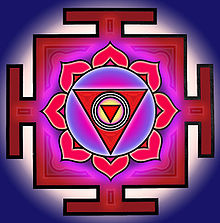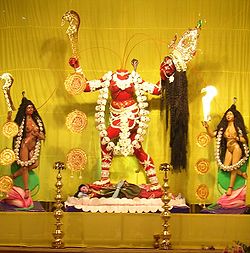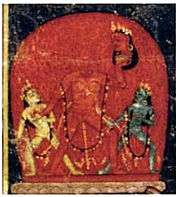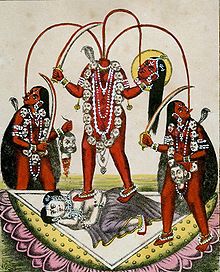- Chhinnamasta
-
For the village of this name in Nepal, see Chhinnamasta, Nepal.
Chinnamasta
Chhinnamasta, at a Kali Puja Pandal, Kolkata.Devanagari छिन्नमस्ता Affiliation Mahavidya, Devi Abode Cremation ground Mantra Srim hrim klim aim Vajravairocaniye hum hum phat svaha Weapon khatri – scimitar Consort Shiva Chhinnamasta (Sanskrit: छिन्नमस्ता, Chinnamastā, "She whose head is severed"), often spelled Chinnamasta and also called Chhinnamastika and Prachanda Chandika, is one of the Mahavidyas, ten Tantric goddesses and a ferocious aspect of Devi, the Hindu Divine Mother. Chhinnamasta can be easily identified by her fearsome iconography. The self-decapitated goddess holds her own severed head in one hand, a scimitar in another. Three jets of blood spurt out of her bleeding neck and are drunk by her severed head and two attendants. Chhinnamasta is usually depicted standing on a copulating couple.
Chhinnamasta is associated with the concept of self-sacrifice as well as the awakening of the kundalini – spiritual energy. She is considered both as a symbol of self-control on sexual desire as well as an embodiment of sexual energy, depending upon interpretation. She symbolizes both aspects of Devi: a life-giver and a life-taker. Her legends emphasize her sacrifice – sometimes with a maternal element, her sexual dominance and her self-destructive fury. Though she enjoys patronage as part of the Mahavidyas, her individual temples – mostly found in Northern India and Nepal – and individual public worship is rare, due to her ferocious nature and her reputation of being dangerous to approach and worship. Her individual worship is restricted to heroic, Tantric worship by Tantrikas, yogis and world renouncers.
Chhinnamasta is recognized by both Hindus and Buddhists. She is closely related to Chinnamunda – the severed-headed form of the Tibetan Buddhist goddess Vajrayogini.
Contents
Origins
Chhinnamasta is popular in Tantric and Tibetan Buddhism, where she is called Chinnamunda ("she with a severed-head") – the severed-head form of goddess Vajrayogini or Vajravarahi – a ferocious form of the latter, who is depicted similar to Chhinnamasta.[1]
Buddhist texts tell of the birth of the Buddhist Chinnamunda. A tale tells of Krishnacharya's disciples, two Mahasiddha sisters, Mekhala and Kankhala, who cut their heads, offered them to their guru and then danced. The goddess Vajrayogini also appeared in this form and danced with them. Another story recalls princess Lakshminkara, who was a previous incarnation of a devotee of Padmasambhava, cut off her head as a punishment from the king and roamed with it in the city, where citizens extolled her as Chinnamunda-Vajravarahi.[2]
The scholar B. Bhattacharya studied various texts such as the Buddhist Sadhanamala (1156 CE), Hindu Chhinnamastakalpa and Tantrasara (17th century); he found that the Hindu Chhinnamasta and Buddhist Chinnamunda are the same, though the former wears a serpent as a sacred thread and has an added Rati-Kamadeva couple in the icon. While Sadhanamala calls the goddess Sarvabuddha ("all-awakened"), with the attendants Vajravaironi and Vajravarnini, the Hindu Tantrasara calls her Sarvasiddhi ("all-accomplished") with attendants Dakini, Vaironi and Varnini. Chhinnamastakalpa calls her Sarvabuddhi ("all-enlightened"), while retaining the Buddhist names for her attendants. Bhattacharya concludes that the Hindu Chhinnamasta originated from the Buddhist Chinnamunda, which was worshipped by at least the 7th century.[3]
While Bhattacharya's view is mostly undisputed,[4][5][6] some scholars like Shankaranarayanan attribute her to Vedic (ancient Hindu) antecedents. S. Bhattacharji says that the Vedic goddess Nirrti's functions were inherited by Kali, Chamunda, Karali and Chhinnamasta. Hindu literature first mentions her in the upapurana Shakta Maha-bhagavata Purana (c. 950 CE) and Devi-Bhagavata Purana. Benard says that whatever her origins may be, it is clear that Chhinnamasta/Chinnamunda was known in the 9th century and worshipped by Mahasiddhas.[4] Apart from Chinnamunda, van Kooij also associates the iconography of Chhinnamasta to Tantric goddesses Varahi and Chamunda.[7]
David Kingsley agrees with the Buddhist origin theory, but acknowledges other influences too. According to Kingsley, the concept of ten Mahavidyas may not be earlier than the 12th century.[6] Ancient Hindu goddesses, who are depicted nude and headless or faceless, may have also influenced the development of Chhinnamasta. These goddesses are mainly depicted headless to focus on the display of their sexual organs, thus signifying sexual vigour, but they do not explain the self-decapitation theme.[6][8] Other Hindu goddesses which might have inspired Chhinnamasta are the malevolent war goddess Kotavi and the South-Indian hunting goddess Korravai. Kotavi, sometimes described as a Matrika ("mother goddess") is nude, dishevelled, wild and awful in appearance. She is mentioned in the scriptures Vishnu Purana and Bhagavata Purana, often as a foe of god Vishnu. The ferocious, wild Korravai is the goddess of war and victory. Both these goddesses are linked to battlefields, while Chhinnamasta is not.[8] Kingsley says that there are several blood-thirsty, nude and wild goddesses and demonesses in Hindu mythology, though Chhinnamasta is the only goddess which displays the shocking self-decapitation motif.[9][10]
Legends and textual references
 A 18th century painting from Rajasthan depicts Chhinnamasta as black as described in Pranotasani Tantra legend. She is seated on the copulating couple.
A 18th century painting from Rajasthan depicts Chhinnamasta as black as described in Pranotasani Tantra legend. She is seated on the copulating couple.
Chhinnamasta is often named as the fifth Mahavidya in the group, with hymns identifying her as a fierce aspect of the Goddess. Kinsley says three Mahavidyas – Kali, Tara and Chhinnamasta — are prominent among Mahavidya depictions and lists, though Chhinnamasta hardly has an independent existence outside the group.[11][12] Guhyatiguhya-Tantra equates god Vishnu's ten avatars with the ten Mahavidyas; the man-lion incarnation Narasimha is described to have arisen from Chhinnamasta.[13] A similar list in Mundamala equates Chhinnamasta with Parshurama.[14]
In a story from the Shakta Maha-Bhagavata Purana, which narrates the creation of all Mahavidyas including Chhinnamasta, Sati, the daughter of Daksha and the first wife of the god Shiva, feels insulted that she and Shiva are not invited to Daksha's yagna ("fire sacrifice") and insists on going there, despite Shiva's protests. After futile attempts to convince Shiva, the enraged Sati assumes a fierce for, transforming into the Mahavidyas, who surround Shiva from the ten cardinal directions. Chhinnamasta stands to the right of Shiva in the west.[15][16][17] Similar legends replace Sati with Parvati, the second wife of Shiva and reincarnation of Sati or Kali, the chief Mahavidya, as the wife of Shiva and origin of the other Mahavidyas. While Parvati uses the Mahavidyas to stop Shiva from leaving her father's house, Kali enlightens him and stops him, who was tired living with her, from leaving her.[18] Devi Bhagavata Purana mentions the Mahavidyas as war-companions and forms of the goddess Shakambhari.[19]
Pranotasani Tantra narrates two tales of Chhinnamasta's birth. One legend, attributed to Narada-pancharatra tells that once, while having a bath in Mandakini river, Parvati becomes sexually excited, turning her black. At the same time, her two female attendants Dakini and Varnini (also called Jaya and Vijaya) become extremely hungry and beg for food. Though Parvati initially promises to give them food once they return home, later the merciful goddess beheaded herself by her nails and gave her blood to satiate their hunger. Later, they returned home.[20][21] The other variant from Pranotasani Tantra, attributed to Svatantra-tantra, is narrated by Shiva. He recounts that his consort Chandika (identified with Parvati) was engrossed in coitus with him in reverse posture, but became enraged at his seminal emission. Her attendants Dakini and Varnini rose from her body. The rest of the tale is similar to the earlier version, although the river is called Pushpabhadra and the day of Chhinnamasta's birth is called Viraratri. This version is also retold in Shaktisamgama-tantra.[22]
An oral legend records the goddess Prachanda-Chandika appeared to aid the gods in the god-demon war, when the gods prayed to the Great Goddess Mahashakti. After slaying all demons, the enraged goddess cut off her own head too and drank her own blood. The name Prachanda-Chandika also appears as a synonym of Chhinnamasta in her hundred-name hymn in Shakta-pramoda.[22] Another oral legend relates her to the Samudra manthan (Churning of Ocean) episode, where the gods and demons churned the milk ocean to acquire the amrita (the elixir of immortality). Chhinnamasta drank the demons' share of the elixir and then beheaded herself to prevent them from acquiring it.[23]
The central themes of the mythology of Chhinnamasta are her self-sacrifice – with a maternal aspect (in the Pranotasani Tantra versions) or for the welfare of the world (in oral version 2) – her sexual dominance (second Pranotasani Tantra version) and her self-destructive fury (in oral legend 1).[24]
Iconography
A Kangra painting (c. 1800 CE) of Chhinnamasta.
Chhinnamasta is described as being as red as the hibiscus flower or as bright as a million suns. She is depicted mostly nude and with dishevelled hair. She is described to be a sixteen-year-old girl with full breasts, having a blue lotus near her heart. Chhinnamasta is depicted wearing a serpent as a sacred thread and a garland of skulls/severed heads and bones, along with other ornaments around her neck. She carries her own severed head – sometimes in a platter or a skull-bowl – in her left hand and holding a khatri, a scimitar or knife or scissor-like object, in her right hand, by which she decapitated herself. A crown on the severed head and bangles, waist-belt ornaments may be also depicted. Three streams of blood string from her neck, one enters her own mouth, while the others are drunk by her female yogini companions, who flank her. Both the attendants – Dakini to her left and Varnini to her right – are depicted nude, with matted or dishevelled hair, three-eyed, full-breasted, wearing the serpentine sacred thread and carrying the skull-bowl in the left hand and the knife in the right. While Dakini is fair and represents the tamas guna, Varnini is red-complexioned and conveys the rajas guna. With her right leg stretched and left leg bent a little, Chhinnamasta stands in a fighting posture on the love-deity couple of Kamadeva (Kama) – a symbol of sexual lust – and his wife Rati, who are engrossed in copulation with the latter usually on the top (viparita-rati sex position). Below the couple is a lotus and in the background is a cremation ground.[20][25][26][27] This popular iconographic form is described in the Tantrasara and the Trishakti Tantra.[20]
Sometimes, the attendants also hold severed heads (not their own).[28] Sometimes, Kamadeva-Rati is replaced by the divine couple of Krishna and Radha.[15] The lotus beneath the couple is sometimes replaced by a cremation pyre. The coupling couple is sometimes omitted completely. Sometimes, Shiva – the goddess's consort – is depicted lying beneath Chhinnamasta, who is seated squatting on him and copulating with him.[29]
Chhinnamasta's popular iconography is similar to the yellow coloured severed-head form of the Buddhist goddess Vajrayogini, except the copulating couple – which is exclusive to the former's iconography – and Chhinnamasta's red skin tone.[5][6]
Chhinnamasta Tantra describes the goddess sitting on Kamadeva, rather than standing on him. Additionally, she is described as three-eyed, with a jewel on her forehead, which is tied to a snake and her breasts adorned with lotuses.[20] Another form of the goddess in the Tantrasara describes her seated in her own navel, formless and invisible. This form is said to be only realised via a trance.[20]
Sometimes, Chhinnamasta is depicted as four-armed, and without the copulating couple. She is depicted on a grass patch, holding the sword with dripping blood in her upper right hand, a breaded head – identified with Brahma – in the lower one. Her upper left hand carries her own severed head, spilling blood in a skull-cup in her lower hand. Her two attendants depicted as skeletons drinking the dripping blood, while two jackals drinking the blood dripping from the head of the goddess and Brahma.[30]
The scholar van Kooij notes that the iconography of Chhinnamasta have the elements of heroism (vira rasa) and terror (bhayanaka rasa) as well as eroticism (sringara rasa) in terms of the copulating couple, with the main motifs being the offering of her own severed head, the spilling and drinking of blood and the trampling of the couple.[31]
Symbolism and associations
Chhinnamasta signifies that life, death and sex are interdependent. Chhinnamasta's image conveys the eternal truth that "life feeds on death, is nourished by death, necessitates death, and that the ultimate destiny of sex is to perpetuate more life, which in turn will decay and die in order to feed more life".[25] While the lotus and the lovemaking couple symbolize life and the urge to create life, in a way gives life-force to the beheaded goddess, the blood flowing from goddess conveys death and loss of the life-force, which flows into the mouths of her devotee yoginis, nourishing them.[25][32] The scholar P. Pal equates Chhinnamasta with the concept of sacrifice and renewal of creation. Chhinnamasta self-sacrifices herself and her blood – drunk by her attendants – nourishes the universe.[33] An invocation to her calls her the sacrifice, the sacrificer and the recipient of the sacrifice, with the severed head treated as an offering.[25][34][35]
While other fierce Hindu goddesses like Kali are depicting severing the heads of demons and are associated with ritual self-decapitation, Chhinnamasta's motif also reverses ritual head-offering, in which she offers her own head to the devotees (attendants) to feed them. In this way, she symbolizes the aspect of the Goddess as a giver. At the same time, she subdues and takes the life-force of the copulating divine couple, signifying the aspect of the life-taker like Kali.[6]
Chhinnamasta standing on a copulating couple of Kamadeva (literally "sexual desire") and Rati ("sexual intercourse") is interpreted by some as a symbol of self-control of sexual desire, while others interpret it as the goddess, being an embodiment of sexual energy. Her names like Yogini and Madanatura ("one who has control on Kama") convey her yogic control and restraint on sexual energy.[36] Images in which Chhinnamasta is depicted sitting on Kamadeva-Rati in a non-suppressive fashion, the couple giving sexual energy to the goddess, and where Shiva is depicted in coitus with Chhinnamasta are associated with the other interpretation. Chhinnamasta's names like Kameshwari ("goddess of desire") and Ratiragavivriddhini ("one who is engrossed in the realm of Rati – [copulation or sexual desire]") and the appearance of klim – the common seed syllable of Kamadeva and Krishna – in her mantra support this interpretation.[37]
Acarya Ananda Jha, the author of the Chinnamasta Tattva, prescribes her worship by soldiers as she embodies self-control of lust, heroic self-sacrifice for the benefit of others and fearlessness of death. Her nudity and headlessness symbolise her integrity and "heedlessness". Her names like Ranjaitri ("victorious in war") celebrate her as the slayer of various demons and her prowess in battle.[38]
The Chhinnamasta icon is also understood as a representation of the awakening of the kundalini – spiritual energy. The copulating couple represent the awakening in the Muladhara chakra, which corresponds to the last bone in the spinal cord. The kundalini flows through the central passage in the body – the Sushumna nadi and hitting the topmost chakra, the Sahasrara at the top of head – with such force that it blows her head out. The blood spilling from the throat applies the upward-flowing kundalini, breaking all knots (granthis) – which make a person sad, ignorant and weak – of the chakras. The severed head is "transcendent consciousness". The three blood streams is the flow of nectar when the kundalini unites with Shiva, who resides in the Sahasrara. Another interpretation associates Daknini, Varnini and Chhinnamasta with the three main subtle channels (nadis): Ida, Pingala and Sushumna flowing free.[39][40][41] Sushumna connects the Muladhara and Sahasrara and is cognate with the spinal cord. Ida courses from the right testicle to the left nostril and is linked to the cooling lunar energy and the right hand side of the brain. Pingala courses from the left testicle to the right nostril and is associated with the hot solar energy and the left hand side of the brain.
The self-decapitation also represents removal of false notions, ignorance and egoism. The ability to remain alive despite the beheading is associated to supernatural powers and awakening of the kundalini.[42] The triad of the goddess and the two yoginis is also philosophically cognate to the triad of patterns, "which creative energy is felt to adopt".[20]
Worship
 The yantra of Chhinnamasta.
The yantra of Chhinnamasta.
While she is easily identified by most Hindus and often worshipped and depicted as part of the Mahavidya group in goddess temples, Chhinnamasta is not so popular as an individual goddess. Her individual temples as well as her public worship are rare. Her individual worship is restricted to heroic, Tantric worship by Tantrikas (a type of Tantric practitioners), yogis and world renouncers. The lack of her worship is attributed by Kinsley to her ferocious nature and her reputation of being dangerous to approach and worship.[9][43] Her hundred-name hymn and thousand-name hymn describe her fierce nature and wrath. The names describe her as served by ghosts and as gulping blood. She is pleased by human blood, human flesh and meat, and worshipped by body hair, flesh and fierce mantras.[43]
Tantric practitioners worship Chhinnamasta for acquiring siddhis or supernatural powers.[9] Chhinnamasta's mantra Srim hrim klim aim Vajravairocaniye hum hum phat svaha is to be invoked to attract and subjugate women.[44][45] Another goal of her worship is to cast spells and cause harm to someone.[20] Other goals common to worship of all mahavidyas are: poetic speech, well-being, control of one's foes, removal of obstacles, ability to sway kings, ability to attract others, conquest over other kings and finally, moksha (salvation).[43][46]
The Tantric texts Tantrasara, Shakta-pramoda and Mantra-mahodadhih (1589 CE)[47] give details about the worship of Chhinnamasta and other Mahavidyas, including her yantra, mantra and her meditative/iconographic forms (dhyanas).[43] Tantric texts tells the worshipper to imagine a red sun orb – signifying a yoni triangle – in his own navel. In the orb, the popular form of Chhinnamasta is imagined to reside.[20] Tantrasara cautions a householder-man to invoke the goddess only in "abstract terms". It further tells that if woman invokes Chhinnamasta by her mantra, the woman will become a dakini and lose her husband and son, thereby becoming a perfect yogini.[20] Shaktisamgama-tantra prescribes her worship only by the left-handed path (Vamamarga). Mantra-mahodadhih declares that such worship involves having sexual intercourse with a woman, who is not one's wife. Shakta-pramoda tells the same, adding fire offerings, wine and meat offerings at night.[48] Some hymns narrate that she likes blood and as such, is offered blood sacrifices at some shrines.[49] Shaktisamgama-tantra says that only brave souls (viras) should follow Vamamarga worship to the goddess. Shakta-pramoda warns that improper worship would have severe consequences: Chhinnamasta would severe the head of such a person and drink his blood. It further categorizes worship for Chhinnamasta to followed by householders and renouncers.[48]
Chhinnamasta Temple at Bishnupur, Bankura, West Bengal.
The Chintapurni, Himachal Pradesh temple to Chhinnamasta claims to be one of the Shakti Peeths and where the goddess Sati's forehead (mastaka) fell. Here, Chhinnamasta is interpreted as the severed-headed one as well as the foreheaded-one.[50] A shrine dedicated to Chhinnamasta exists in Ramnagar, near Varanasi, where tantrikas worship her using corpses. There are Chhinnamasta shrines in Jharkhand (formerly Bihar) on the hill Nandan Parvat near Deoghar (Vaidyanath) and in Ranchi, along with other Mahavidyas. Her shrine is situated in the Kamakhya Temple complex, Assam, along with other Mahavidyas. A temple to Chhinnamasta is present in Vishnupur (Bishnupur), West Bengal. Chhinnamasta's shrines are also found in Nepal's Kathmandu Valley, notably near the Changu Narayan temple. The earliest of these temples is dated by Benard to the late 17th century.[48][51][52]
See also
- Devi
- Mahavidya
- Cephalophore: Christian saints depicted holding their own severed heads
References
- ^ Kinsley (1988, p. 172)
- ^ Benard (2000, pp. 9–11)
- ^ Benard (2000, pp. 12–5)
- ^ a b Benard (2000, pp. 16–7)
- ^ a b Donaldson (2001, p. 411)
- ^ a b c d e Kinsley (1988, p. 175)
- ^ van Kooij (1999, p. 266)
- ^ a b Kinsley (1988, p. 176)
- ^ a b c Kinsley (1988, p. 177)
- ^ Kinsley (1997, pp. 144–7)
- ^ Kinsley (1988, p. 165)
- ^ Kinsley (1997, pp. 2, 5, 9)
- ^ Kinsley (1988, p. 161)
- ^ Benard (2000, p. 5)
- ^ a b Kinsley (1988, p. 162)
- ^ Kinsley (1997, p. 23)
- ^ Benard (2000, pp. 1–3)
- ^ Kinsley (1997, pp. 28–29)
- ^ Kinsley (1997, p. 31)
- ^ a b c d e f g h i Donaldson (2001, p. 412)
- ^ Kinsley (1997, pp. 147–8)
- ^ a b Kinsley (1997, p. 148)
- ^ Kinsley (1997, p. 21)
- ^ Kinsley (1997, pp. 149–50)
- ^ a b c d Kinsley (1988, p. 173)
- ^ Kinsley (1997, p. 144)
- ^ van Kooij (1999, p. 258)
- ^ Kinsley (1997, p. 151)
- ^ Kinsley (1997, p. 11)
- ^ Donaldson (2001, p. 413)
- ^ van Kooij (1999, pp. 255, 264)
- ^ Kinsley (1997, pp. 157–9)
- ^ Kinsley (1997, p. 50)
- ^ Benard (2000, p. xv)
- ^ van Kooij (1999, p. 252)
- ^ Kinsley (1997, p. 154)
- ^ Kinsley (1997, pp. 155–7)
- ^ Kinsley (1997, p. 155)
- ^ Kinsley (1997, pp. 159–61)
- ^ Benard (2000, pp. xii–xiii)
- ^ van Kooij (1999, pp. 249–50)
- ^ Kinsley (1997, pp. 163–4)
- ^ a b c d Kinsley (1997, p. 164)
- ^ Kinsley (1997, p. 157)
- ^ Benard (2000, p. 34)
- ^ van Kooij (1999, p. 260)
- ^ Benard (2000, p. 84)
- ^ a b c Kinsley (1997, pp. 165–6)
- ^ Kinsley (1997, p. 147)
- ^ Benard (2000, p. 4)
- ^ Benard (2000, pp. 145–7)
- ^ van Kooij (1999, p. 261)
- Books
- Benard, Elizabeth Anne (2000), Chinnamasta: The Aweful Buddhist and Hindu Tantric Goddess, Motilal Banarsidass, ISBN 978-8120817487
- Donaldson, Thomas E. (2001), Iconography of the Buddhist Sculpture of Orissa, New Delhi: Indira Gandhi Nation Centre for Arts (Abhinav Publications), pp. 411–3, ISBN 978-8170174066, http://books.google.com/?id=DbxE8zOuRbUC&pg=PA411&dq=Chinnamasta&cd=3#v=onepage&q=Chinnamasta
- Kinsley, David R. (1988), "Tara, Chinnamasta and the Mahavidyas", Hindu Goddesses: Visions of the Divine Feminine in the Hindu Religious Tradition (1 ed.), University of California Press, pp. 161–177, ISBN 978-0520063396, http://books.google.com/?id=ZDquQXm0bDsC&printsec=frontcover&dq=editions:ISBN0520063392&q= (1998 edition depicts Chinnamasta on the front page)
- Kinsley, David R. (1997), Tantric visions of the divine feminine: the ten mahāvidyās, University of California Press., ISBN 978-0520204997, http://books.google.com/?id=oMW8WTrotKsC&pg=PA144&dq=Chinnamasta&cd=4#v=onepage&q=Chinnamasta (This edition depicts Chinnamasta on the front page)
- van Kooij, Karel R. (1999), "Iconography of the Battlefield: The Case of Chinnamasta", in Houben, Jan E. M.; van Kooij, Karel R., Violence Denied, BRILL, ISBN 9004113444, http://books.google.com/?id=6znfIA3UfWcC&printsec=frontcover&dq=editions:ISBN9004113444&q=Chinnamasta
Mahavidya Kali · Tara · Tripura Sundari · Bhuvaneshvari · Bhairavi · Chhinnamasta · Dhumavati · Bagalamukhi · Matangi · Kamalatmika
Hindu deities and texts Gods 
Goddesses Texts Categories:- Hindu goddesses
- Forms of Parvati
- Mahavidyas
Wikimedia Foundation. 2010.






